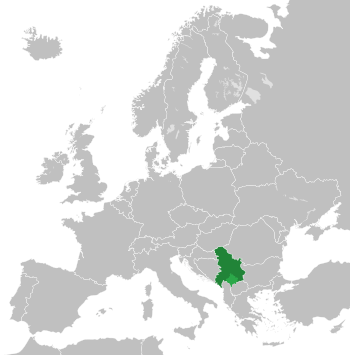Serbia and Montenegro facts for kids
Quick facts for kids
State Union of Serbia and Montenegro
Државна Заједница Србија и Црна Гора
Državna zajednica Srbija i Crna Gora |
|||||||||||
|---|---|---|---|---|---|---|---|---|---|---|---|
| 1992–2006 | |||||||||||
 |
|||||||||||
| Status | Federal republic (1992-2003), State Union (2003-2006) |
||||||||||
| Capital | Belgrade | ||||||||||
| Common languages | Serbo-Croatian (1992-1997) Serbian (1997-2006) |
||||||||||
| Government | republic | ||||||||||
| President | |||||||||||
|
• 1992–1993
|
Dobrica Ćosić | ||||||||||
|
• 1993–1997
|
Zoran Lilić | ||||||||||
|
• 1997–2000
|
Slobodan Milošević | ||||||||||
| Prime Minister | |||||||||||
|
• 1992–1993
|
Milan Panić | ||||||||||
|
• 1993–1998
|
Radoje Kontić | ||||||||||
|
• 1998–2000
|
Momir Bulatović | ||||||||||
|
• 2000–2001
|
Zoran Žižić | ||||||||||
|
• 2001–2003
|
Dragiša Pešić | ||||||||||
|
• 2003-2006
|
Svetozar Marović | ||||||||||
| Historical era | Post–Cold War | ||||||||||
|
• Constitution
|
April 27, 1992 | ||||||||||
|
• Established
|
April 28 1992 | ||||||||||
| November 1, 2000 | |||||||||||
|
• Reconstitution as the State Union
|
February 4, 2003 | ||||||||||
|
• Dissolution of the State Union
|
June 5 2006 | ||||||||||
| Area | |||||||||||
| 2006 | 102,350 km2 (39,520 sq mi) | ||||||||||
| Population | |||||||||||
|
• 2006
|
10832545 | ||||||||||
| Currency | Yugoslav dinar (1992-2003) Serbian dinar (Serbia 2003-2006) Deutsche Mark (Montenegro 1999-2002) Euro (Montenegro 2002-2006) |
||||||||||
| Calling code | 381 | ||||||||||
| Internet TLD | .yu | ||||||||||
|
|||||||||||
Serbia and Montenegro (Serbian: Србија и Црна Гора, Srbija i Crna Gora, often called "SCG") was a country in Europe. It was a union of two parts: Serbia and Montenegro. These two parts used to be separate republics within a larger country called Yugoslavia. In 2006, Serbia and Montenegro officially split and became two independent countries.
Contents
Where Was Serbia and Montenegro Located?
This country was in the west-central part of the Balkan Peninsula. It shared borders with several other countries. To the west, it bordered Bosnia and Herzegovina and Croatia. To the north was Hungary. On its eastern side, it bordered Romania and Bulgaria. To the south was the Republic of Macedonia, and to the southwest was Albania. It also had a short coastline of just over 200 kilometers along the Adriatic Sea.
How Did Serbia and Montenegro Work?
Serbia and Montenegro were united under one government, but they worked together in only some political areas. This meant they had a lot of freedom to make their own choices. For example, Serbia and Montenegro had separate economic policies. They even used different types of money (currencies) in some periods. Even though they were a single country, they allowed their parts to have more control over their own affairs than before.
Becoming Separate Countries
Many people in Montenegro wanted their region to be fully independent. So, on May 21, 2006, Montenegro held a special vote. This vote asked the people of Montenegro if they wanted to leave the union and become an independent country. The results showed that 55.5% of the voters chose independence.
Because of this vote, Montenegro officially declared its independence on June 3, 2006. Just two days later, on June 5, Serbia also declared its independence. This marked the end of Serbia and Montenegro as a single country.
Images for kids
-
Supporters of the national football team during the 2006 FIFA World Cup
See also
 In Spanish: Serbia y Montenegro para niños
In Spanish: Serbia y Montenegro para niños








